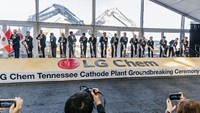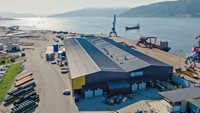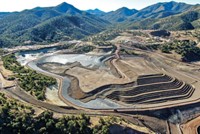Advertisement
Grab your lab coat. Let's get started
Welcome!
Welcome!
Create an account below to get 6 C&EN articles per month, receive newsletters and more - all free.
It seems this is your first time logging in online. Please enter the following information to continue.
As an ACS member you automatically get access to this site. All we need is few more details to create your reading experience.
Not you? Sign in with a different account.
Not you? Sign in with a different account.
ERROR 1
ERROR 1
ERROR 2
ERROR 2
ERROR 2
ERROR 2
ERROR 2
Password and Confirm password must match.
If you have an ACS member number, please enter it here so we can link this account to your membership. (optional)
ERROR 2
ACS values your privacy. By submitting your information, you are gaining access to C&EN and subscribing to our weekly newsletter. We use the information you provide to make your reading experience better, and we will never sell your data to third party members.
Business
Powerful Stuff
Materials get attention and funding in effort to create U.S. lithium battery industry
by Melody Voith
September 7, 2009
| A version of this story appeared in
Volume 87, Issue 36

The Obama Administration’s support for U.S. electric-car manufacturing has inspired television crews to descend on Chemetall Foote’s lithium chemical operations in Chile’s Atacama Desert and in Silver Peak, Nev. Far from major cities, both locations are reached only after hours of driving on roads that are not well marked. So lately, Timothy McKenna, vice president of investor and government relations for Rockwood Holdings, Chemetall’s parent company, has the job of keeping members of the media from getting lost in the desert.
“We figured if this caught on, we would probably see this kind of interest,” McKenna tells C&EN via cell phone from Chile. Lithium chemicals such as those made by Chemetall are key to lithium-ion batteries, the source of power for most upcoming models of plug-in hybrid and all-electric vehicles.
Making materials for lithium-ion batteries has caught on in a big way. In August, the Department of Energy announced that Chemetall was one of 10 materials suppliers awarded a combined $235 million in grants to help build the supply chain for lithium-ion batteries (C&EN, July 27, page 24). The grants are part of a larger, $2.4 billion in funding for advanced vehicles from the American Recovery & Reinvestment Act.
The government’s overall aim is to build an advanced battery industry and lead the global market. The winning materials companies will happily use the funds to expand their U.S. facilities. But across the board they stress that they are competing internationally and don’t require a U.S. car battery industry to succeed. In fact, several executives point out, global competition is tough, and it is not clear that the center of battery manufacturing will ever tilt away from Asia.
Globally, the companies that produce materials for lithium-ion batteries see the auto industry as a growth business. Today, almost all of their customers are in Asia, and their materials go into lithium-ion batteries for consumer electronics, not cars. But with the new push to build a domestic electric-car industry, they found themselves in position to win federal funds.
“Electric vehicles are likely to reignite growth in lithium,” McKenna says. “That’s why we’re expanding the Silver Peak operation and our processing at Kings Mountain, N.C. We already make lithium hydroxide but want to make very-high-purity lithium hydroxide for batteries.”
McKenna observes that 20% of the world’s lithium goes to produce lithium-ion batteries. Even without an electric-car market, the lithium sector enjoys a 5–10% annual growth rate. In the next two to three years, battery-powered cars could add an additional 8% to the growth rate for lithium. McKenna estimates that each new plug-in hybrid or all-electric vehicle would require 15 lb of lithium.
Chemetall will receive $28.4 million to expand in Nevada and North Carolina. But in spite of all the attention on the U.S. market, “it probably doesn’t matter to us where the electric cars are built. It probably doesn’t matter where the batteries are built, either. We are already supplying battery makers,” McKenna says.
He notes that only three big companies—Chemetall, FMC, and SQM—make battery-grade lithium hydroxide, mostly in Chile. In fact, Chemetall obtains 85% of its lithium from Chile’s Salar de Atacama. But U.S. battery makers are likely to look to the company because it’s the only firm that also produces in the U.S.
It’s not surprising that material suppliers are not counting on U.S. battery manufacturing, says Willy C. Shih, professor of management practice at Harvard Business School. The government can offer incentives for battery production, and materials suppliers will respond to demand for their ingredients, at least for a while. “If you have firms that manufacture in the U.S., you can set up a demand cycle,” Shih points out. But in the long run, global economics will rule, he says. “The big question is, ‘How competitive is it on a world cost basis?’ ”
Novolyte, a manufacturer of battery electrolytes for some 30 years, has already followed demand to Asia. “In the mid-1990s, we saw lithium ion taking off and expanded our plant in Baton Rouge, La.,” says Ed Frindt, the firm’s chief executive officer. “In early 2001, we saw the shift taking place for more battery production in Asia and in 2004 built a facility in Suzhou, China.”
Novolyte received a $20.6 million grant to expand in Baton Rouge. Like Chemetall, the company doesn’t have competition in the U.S. “We’re the only North American manufacturer of electrolytes; the market in this region has been relatively small,” Frindt says. That’s in stark contrast to Asia, he says, where “there are many competitors and different dynamics. We’re working to compete in that segment.”
Frindt says the government support “doesn’t really change our direction. We are already committed to and investing in this business with capital, intellectual property, and development. This just further enhances and supports our business strategy.” Still, he acknowledges that government attention to developing an alternative energy infrastructure “has helped establish a position in the U.S. for manufacturing that might not otherwise have ever developed.”
To meet the significant new demand that it anticipates from the electric-car market, Novolyte will expand its Baton Rouge facility fivefold, making enough electrolyte for at least 100,000 hybrid-electric or all-electric batteries per year. The company will add 30 engineering, technical, and skilled-worker jobs.

Battery separator manufacturer Celgard is another member of the small club of U.S. materials firms supplying lithium-ion battery companies. Celgard, part of Polypore International, received the largest pot of grant money—$49.2 million—to expand its Charlotte, N.C., facility, which makes battery separators from polypropylene, polyethylene, or a combination of the two polymers. The company also plans to build a second plant in an unnamed location.
Mitch Pulwer, general manager of Celgard, is energized by the strong government support, but like the other executives, he says it doesn’t change the company’s strategy. “It’s important for all of us as citizens of the U.S. to have companies over here developing and building batteries for this important next phase of the auto industry,” he says. “We will continue to support customers in Asia, plus customers in the U.S. We’ll supply wherever they are.”
Celgard’s grant application emphasized both its ability to scale up in the U.S. and the jobs that would be added. “We’re going to create over 200 jobs by 2012 directly employed in Celgard,” Pulwer says. “With vendors and subcontractors, there will be about 1,000 indirect jobs associated with this program.”
DOE Secretary Steven Chu traveled to Celgard’s North Carolina facility to announce the grant in person. In his otherwise upbeat remarks, he did not gloss over the challenge facing the U.S. battery industry. He pointed out that “98% of the lithium-ion batteries that power personal electronics are made in Asia. Ninety-nine percent of the batteries that power America’s hybrid cars are made in Japan.”
Harvard’s Shih isn’t giving odds on whether domestic battery manufacturing will take off, but he explains that Asian governments have a knack for working with companies to spur high-tech manufacturing. “They understand why manufacturers move into industrial parks. They want to foster a supplier infrastructure, which creates talent spillover and job trading,” he says.
Shih points to Samsung’s production of flat-panel displays as an example of clustering. “There is a place in South Korea where their suppliers are all located. You can even go to a street market and buy clean-room garb,” he says. Industrial clustering has also been successful in the U.S., he observes, including in Silicon Valley in California; Research Triangle Park, N.C.; and the biotech corridor in and around Cambridge, Mass.
Another advantage that manufacturers enjoy in Asia is the speed of getting huge factories built and in production. “They can put up a factory in nine months. We can’t get zoning approval here in nine months,” Shih says. “I visited one of the big battery makers in South Korea. First they clear a couple hundred hectares, then they put up a prototype factory, and they quickly build many more, all in a row.”
But there is hope for the U.S. Shih suggests that doing business in the U.S. might save some money. When firms outsource, they have to deal with “a combination of transportation cost, shipping time, inventory-carrying cost, holding times, and coordination costs,” Shih contends.
One way that companies in the U.S. could jump ahead of global competition would be to build a better battery.
“It’s an exciting and interesting time to be in this industry,” Novolyte’s Frindt says. “Every formulation is unique to a set of chemistries or cell design.” The firm develops new electrolytes in collaboration with customers. “Whether we’re looking at a higher energy density, longer cycle life, or temperature applications, it’s all based on interactions between the electrolyte and the other materials,” he says.

Although its main products are electrolyte solvents and salts, Novolyte is also working on newer polymer electrolyte systems and even investigating ionic liquids, which can boost performance but are very costly. The company recently added four new positions at its Cleveland research facility. “The product we’re making today won’t be the product we’re making 10 years from now,” Frindt promises.
New technology plus government funding has led BASF to plan U.S manufacturing of battery cathode material on a commercial scale. The company has a worldwide licensing agreement with Argonne National Laboratory for cathode materials, which it is already producing at a pilot plant in Elyria, Ohio.
Prashant S. Chintawar, senior manager with BASF Future Business, says the material contains nickel, lithium, manganese, and cobalt. “It’s not as simple as it sounds—performance varies depending on composition, purity, particle size, and particle distribution.” But it’s worth the effort to get it right. “We believe these materials have the best combination of capacity, power, and safety,” he says.
One of the most important investments for the U.S. battery industry might be in a high-tech workforce. In his visits to Asian factories, Shih noted that the workers were bachelor’s- and master’s-level chemists and engineers. “In Asia, they have extremely skilled people on the floor,” he says. “We need those kinds of people to work in fabrication.” The kind of workforce development Shih suggests is more long-term than what people normally associate with job-training programs.
Celgard’s Pulwer agrees: “I think this is a great opportunity for our universities to support this effort by training people, whether in engineering or electrical chemistry, to participate. I hope that more of America’s universities will understand that this is a fertile area.”
Overall, Shih calls the early steps toward building a U.S. advanced battery supply chain “promising.” Because there is no dominant design or material choice for electric vehicle batteries, “it is a good time to get back into it and try to have manufacturing here,” he says. “But there is a huge amount of process learning as you try to scale it. There is so much infrastructure in Asia for batteries that it will definitely be a come-from-behind effort.”








Join the conversation
Contact the reporter
Submit a Letter to the Editor for publication
Engage with us on Twitter